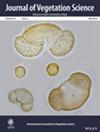Beta-Diversity of Herbaceous Versus Woody Plant Communities Across a Tropical Rainfall Gradient
Abstract
Aim
Most of our current knowledge on tropical forest plant communities is based on trees, despite the substantial contribution of other lifeforms to plant diversity in these systems. In particular, there is a limited number of studies on understory herbaceous plants (herbs) in tropical forests. With their lower dispersal abilities, higher rates of evolution, and lower drought tolerance than trees, herbs are expected to exhibit different patterns of species composition across space. To compare the patterns and drivers of variation in species composition (β-diversity) between these two plant groups, we surveyed tree and herb communities in 13 one-ha plots along a rainfall gradient in a seasonally dry forest in India.
Location
Mudumalai National Park, India.
Methods
In each one-ha plot, we censused all trees ≥ 1 cm DBH in each one-ha plot, and herbs in 47–50 1 × 1 m subplots within each one-ha plot. In both groups, we estimated among-plot β-diversity, which we decomposed into two components: turnover and nestedness. Then we partitioned the relative influences of spatial and environmental predictors, including rainfall, temperature, soil, and fire frequency, on β-diversity.
Results
Contrary to our expectations, β-diversity was remarkably similar for herbs and trees, and both groups exhibited high turnover along the gradient. Rainfall and temperature explained most variation in composition within both groups, while fire and soil explained less variation, and their effects differed between groups.
Conclusions
While trees and herbs show contrasting patterns of α-diversity across the same rainfall gradient, our study suggests that both life forms are impacted strongly by environmental filtering, predominantly rainfall and temperature, resulting in similar patterns of β-diversity. The high turnover observed in tree and herb communities, and the influence of rainfall and temperature in structuring these communities, should be considered when designing conservation and restoration strategies in the face of ongoing global change and other anthropogenic pressures on tropical forests.


 求助内容:
求助内容: 应助结果提醒方式:
应助结果提醒方式:


